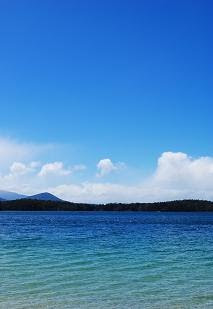Recherche bay is the site of the first scientific experiments on Australian soil. The French explorer Antoine Raymond Joseph de Bruni d’Entrecasteaux (what a groovy name) landed in 1792 and made a garden and observatory and mapped and named parts of Southern Tasmania, which has resulted in Tasmania having some beautiful French names mixed up with Indigenous and English names. Bruni d’Entrecasteaux’s ships included the Recherche and the Esperance.
One of the goals of Bruni d’Entrecasteaux’s voyage was to try and find the explorer Jean-Francois de Galaup, comte de La Perouse who was last seen in Botany Bay in 1788 heading off towards New Caledonia.
Recherche Bay
"It would be vain of me to attempt to describe my feelings when I beheld this lovely harbour lying at the world's end, separated as it were from the rest of the universe.”
- Antoine Raymond Joseph de Bruni d’Entrecasteaux
Beach at Cockle Creek
Cockle Creek is the southern most point that is assessable in Australia. The beach is beautiful, and when I was there the sky and water were beautiful shades of blue.
Cockle Creek is also host to a sad period in Australia’s history being a centre for whaling in the 1830s. A bronze statue of a Southern Right Whale Cub mourns for all the whales killed in the area. The whalers used to kill the cubs and when the adults heard their cries would run in to see what the matter was and then be killed as well.
Whale statue at Cockle Creek - sculptured by Steven Walker
“The next stop is Antarctica. And it’s not that far away. Standing here, you are closer to Antarctica than you are to Cairns.”
- Australian Government – Department of Resources Energy and Tourism
The southernmost point that you can buy food is Ida Bay. Where naturally I had a Devonshire Tea.





No comments:
Post a Comment